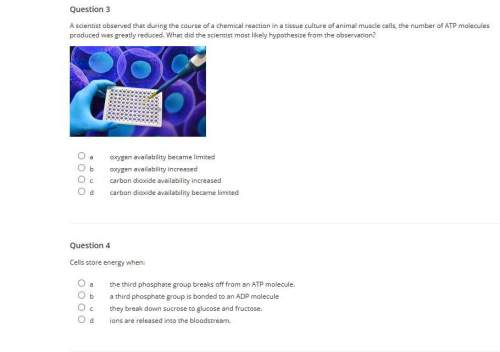Mark as
picture is the questionnn? the picture/screenshot is the questions and questio...

Biology, 27.09.2019 19:10 mimibear2932
Mark as
picture is the questionnn? the picture/screenshot is the questions and question 1 has a picture to the question.
here are the answer choices if you can see them.
question 1: a scientist observed that during the course of a chemical reaction in a tissue culture of animal muscle cells, the number of atp molecules produced was greatly reduced. what did the scientist most likely hypothesize from the observation?
a
oxygen availability became limited
b
oxygen availability increased
c
carbon dioxide availability increased
d
carbon dioxide availability became limited
question 2: cells store energy when?
a
the third phosphate group breaks off from an atp molecule.
b
a third phosphate group is bonded to an adp molecule
c
they break down sucrose to glucose and fructose.
d
ions are released into the bloodstream.


Answers: 2
Another question on Biology

Biology, 22.06.2019 00:30
Imagine that certain laws of physics could be ignored and you were able to travel vast distances in moments. now imagine that you traveled to an earth-like planet located light-years away that is known to support life. think about what you’ve learned in this unit and make an argument for what you think would be the dominant type of life form on this planet. consider whether a notochord is required for an organism to manipulate its environment and become a dominant creature.
Answers: 3

Biology, 22.06.2019 03:30
Rease is an enzyme used by plants to break down urea (a nitrogen-containing compound) into carbon dioxide and ammonia. urease urea > > > carbon dioxide and ammonia ammonia is broken down by plants into a nitrogen source plants need to grow. thus, plants could not use urea as a nitrogen source unless it was first converted to ammonia. in soybean plants there are two different kinds of urease, one produced in the seeds and the other produced in the leaves of the plant. three types of soybean plants were used in a set of experiments: normal soybeans and two mutant strains, one lacking the urease in the seeds only (strain 1) and one lacking urease in the leaves only (strain 2). experiment 1 separate areas in a field were planted with normal, strain 1, and strain 2 soybeans. all types of soybeans appeared to grow, flower, and produce seeds equally well. there were no externally detectable differences among the strains. experiment 2 small pieces of plant leaves of equal weight were obtained from each type of soybean plant and separately placed on media in culture dishes. tissue growing in this way will become an unorganized clump of cells referred to as callus. to provide a controlled nitrogen source, half the tissue samples of each type were placed on media containing urea, and the other half of the samples were placed on media containing ammonia. after 30 days, the weight gain for each of the callus samples was determined. results are shown in the table below.
Answers: 2

Biology, 22.06.2019 06:20
What makes a dominant allele different from a recessive allele
Answers: 2

Biology, 22.06.2019 10:10
(6.02 mc)what affect do marine protected areas have on environmental quality? they increase environmental quality by preventing resource overuse. they increase environmental quality by adding new species. they decrease environmental quality by removing all human activity. they decrease environmental quality by adding recycling facilities.
Answers: 1
You know the right answer?
Questions

History, 06.04.2020 02:56

Biology, 06.04.2020 02:56


Mathematics, 06.04.2020 02:56


Chemistry, 06.04.2020 02:56





Mathematics, 06.04.2020 02:56



Mathematics, 06.04.2020 02:56





Mathematics, 06.04.2020 02:56



